TOYOTA YARIS SEDAN 2010 Owners Manual
Manufacturer: TOYOTA, Model Year: 2010, Model line: YARIS SEDAN, Model: TOYOTA YARIS SEDAN 2010Pages: 386, PDF Size: 6.95 MB
Page 261 of 386

250 4-3. Do-it-yourself maintenance
CAUTION
nTire pressure warning system operation
The tire pressure warning system may not provide warning immediately
if a tire bursts or if sudden air leakage occurs.
nWhen inspecting or replacing tires
Observe the following precautions to prevent accidents. Failure to do so
may cause damage to parts of the drive train, as well as dangerous han-
dling characteristics, which may lead to an accident resulting in death or
serious injury.
lDo not mix tires of different makes, models or tread patterns.
Also, do not mix tires of remarkably different treadwear.
lDo not use tire sizes other than those recommended by Toyota.
lDo not mix differently constructed ti res (radial, bias-belted or bias-ply
tires).
lDo not mix summer, all season and winter tires.
lDo not use tires that have been used on another vehicle.
lDo not use tires if you do not know how they were used previously.
Page 262 of 386

251
4-3. Do-it-yourself maintenance
4
Maintenance and care
NOTICE
nRepairing or replacing tires, whee
ls, tire pressure warning valves
and transmitters and tire valve caps
lWhen removing or fitting the wheels, tires or the tire pressure warning
valve and transmitter, contact your Toyota dealer as the tire pressure
warning valve and transmitter may be damaged if not handled cor-
rectly.
lWhen replacing tire valve caps, do not use tire valve caps other than
those specified. The cap may become stuck.
nTo avoid damaging the tire pressure warning valves and transmit-
ters
Do not use liquid sealants on flat tires.
nDriving on rough roads
Take particular care when driving on roads with loose surfaces or pot-
holes.
These conditions may cause losses in tire inflation pressure, reducing
the cushioning ability of the tires. In addition driving on rough roads may
cause damage to the tires themselves, as well as the vehicle’s wheels
and body.
nIf tire inflation pressures become low while driving
Do not continue driving, or your tires and/or wheels may be ruined.
Page 263 of 386
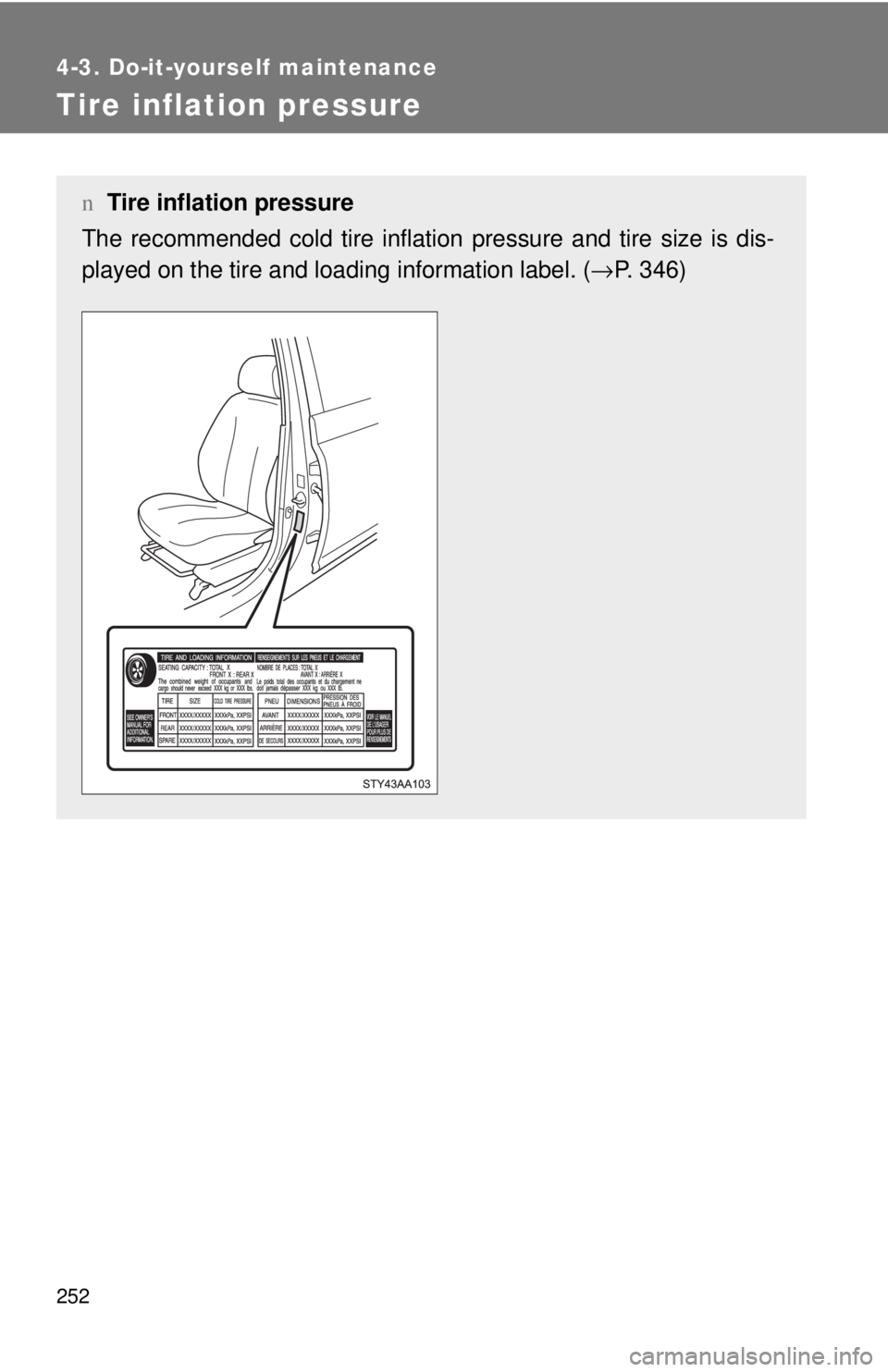
252
4-3. Do-it-yourself maintenance
Tire inflation pressure
nTire inflation pressure
The recommended cold tire inflation pressure and tire size is dis-
played on the tire and loadi ng information label. (→P. 346)
Page 264 of 386
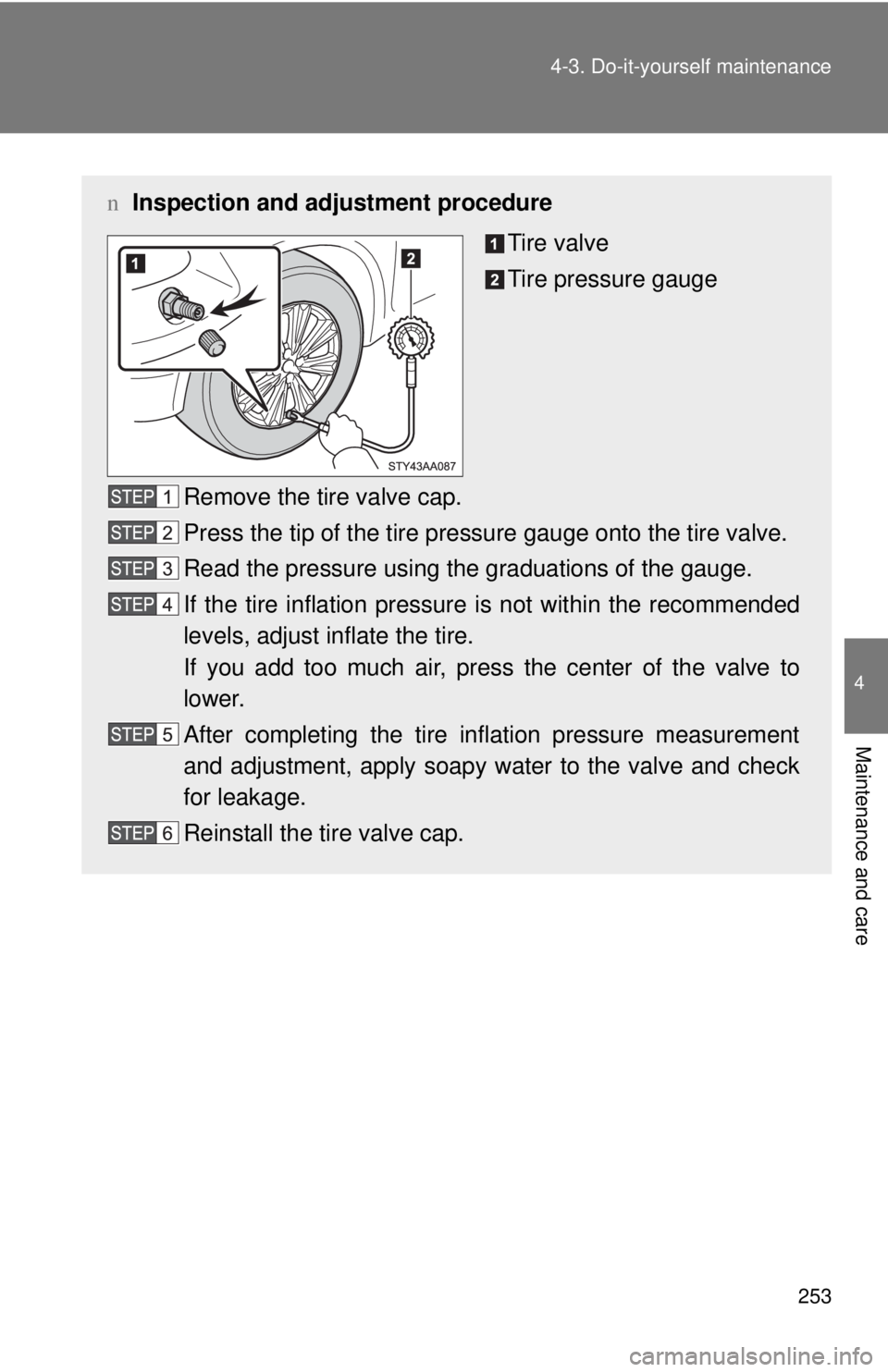
253
4-3. Do-it-yourself maintenance
4
Maintenance and care
n
Inspection and adjustment procedure
Tire valve
Tire pressure gauge
Remove the tire valve cap.
Press the tip of the tire pressure gauge onto the tire valve.
Read the pressure using the graduations of the gauge.
If the tire inflation pressure is not within the recommended
levels, adjust inflate the tire.
If you add too much air, pres s the center of the valve to
lower.
After completing the tire inflation pressure measurement
and adjustment, apply soapy water to the valve and check
for leakage.
Reinstall the tire valve cap.
Page 265 of 386

254 4-3. Do-it-yourself maintenance
nTire inflation pressure check interval
You should check tire pressure every two weeks, or at least once a
month.
Do not forget to check the spare tire.
nEffects of incorrect tire inflation pressure
Driving with incorrect tire inflation pressure ma y result in the following:
lReduced fuel efficiency
lReduced driving comfort and tire life
lReduced safety
lDamage to the drive train
If a tire needs frequent re filling, have it checked by your Toyota dealer.
nInstructions for checking tire inflation pressure
When checking tire inflation pressure, observe the following:
lCheck only when the tires are cold.
If your vehicle has been parked for at least 3 hours and has not been
driven for more than 1 mile or 1.5 km, you will get an accurate cold
tire inflation pressure reading.
lAlways use a tire pressure gauge.
The appearance of the tire can be mi sleading. In addition, tire infla-
tion pressures that are even just a few pounds off can degrade ride
and handling.
lDo not bleed or reduce tire inflation pressure after driving. It is normal
for the tire inflation pressure to be higher after driving.
lNever exceed the vehicle capacity weight.
Passengers and luggage weight should be placed so that the vehicle
is balanced.
Page 266 of 386

255
4-3. Do-it-yourself maintenance
4
Maintenance and care
CAUTION
nProper inflation is critical
to save tire performance
Keep your tires properly inflated.
Otherwise, the following conditions may occur and result in an accident
causing death or serious injury.
lExcessive wear
lUneven wear
lPoor handling
lPossibility of blowouts resu lting from overheated tires
lPoor sealing of the tire bead
lWheel deformation and/or tire separation
lA greater possibility of tire damage from road hazards
NOTICE
nWhen inspecting and adjusting tire inflation pressure
Be sure to reinstall the tire valve caps.
Without the valve caps, dirt or mo isture could get into the valve and
cause air leakage, which could result in an accident. If the caps have
been lost, replace them as soon as possible.
Page 267 of 386
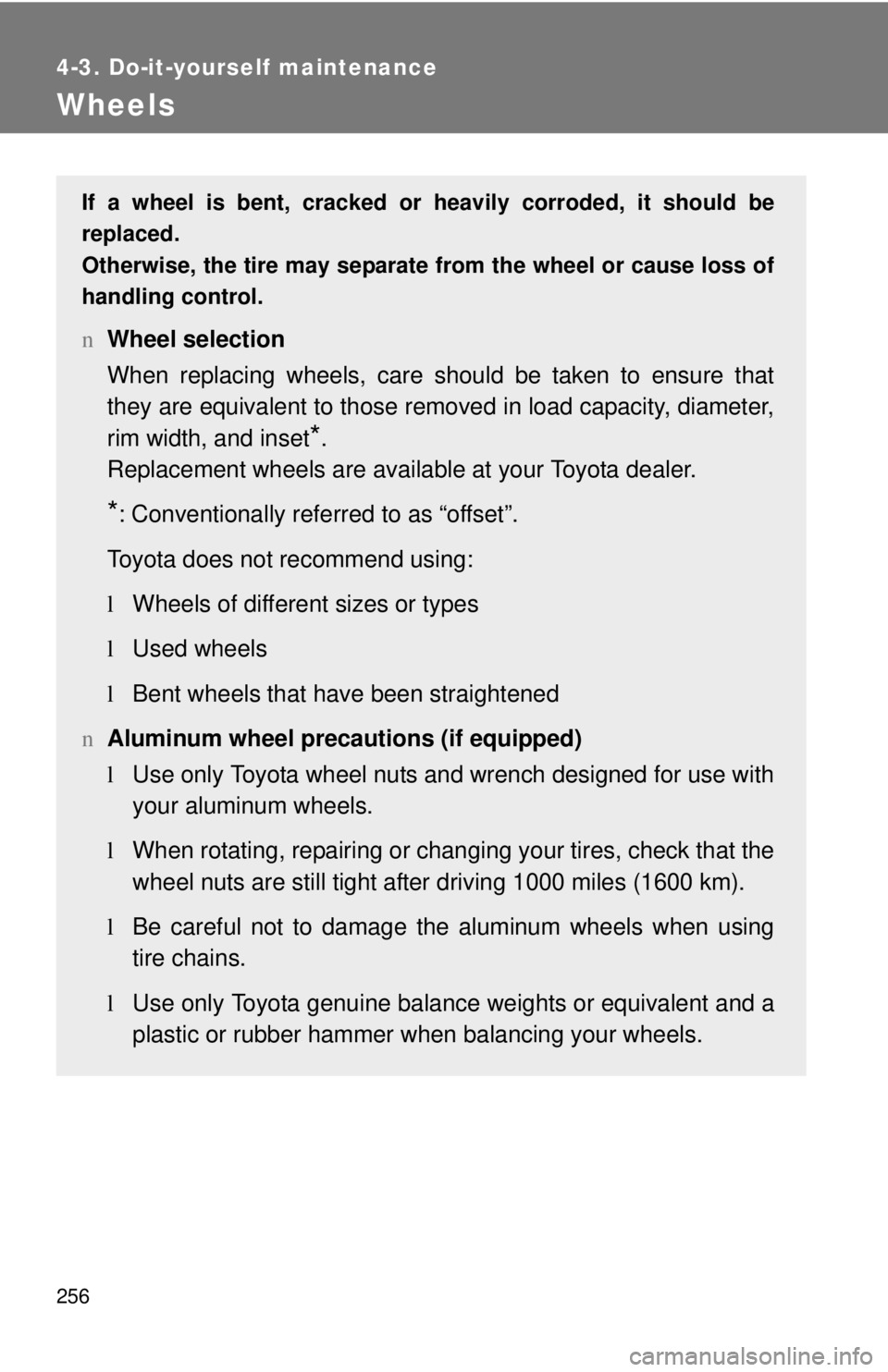
256
4-3. Do-it-yourself maintenance
Wheels
If a wheel is bent, cracked or heavily corroded, it should be
replaced.
Otherwise, the tire may separate from the wheel or cause loss of
handling control.
nWheel selection
When replacing wheels, care should be taken to ensure that
they are equivalent to those removed in load capacity, diameter,
rim width, and inset
*.
Replacement wheels are available at your Toyota dealer.
*: Conventionally referred to as “offset”.
Toyota does not recommend using:
l Wheels of different sizes or types
l Used wheels
l Bent wheels that have been straightened
n Aluminum wheel precautions (if equipped)
lUse only Toyota wheel nuts and wrench designed for use with
your aluminum wheels.
l When rotating, repairing or changing your tires, check that the
wheel nuts are still tight after driving 1000 miles (1600 km).
l Be careful not to damage the aluminum wheels when using
tire chains.
l Use only Toyota genuine balance weights or equivalent and a
plastic or rubber hammer when balancing your wheels.
Page 268 of 386
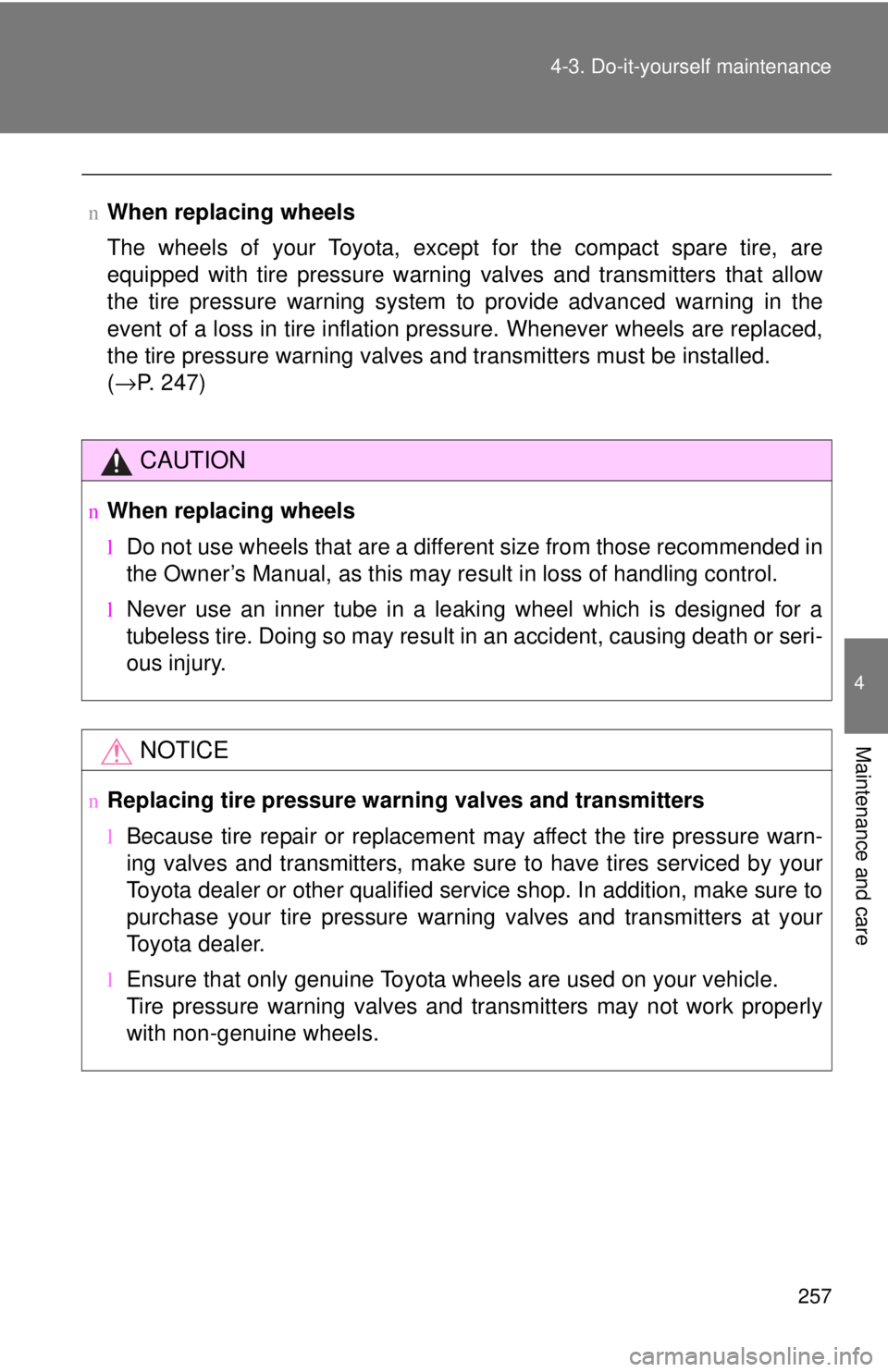
257
4-3. Do-it-yourself maintenance
4
Maintenance and care
nWhen replacing wheels
The wheels of your Toyota, except for the compact spare tire, are
equipped with tire pressure warning valves and transmitters that allow
the tire pressure warning system to provide advanced warning in the
event of a loss in tire inflation pressure. Whenever wheels are replaced,
the tire pressure warning valves a
nd transmitters must be installed.
( → P. 247)
CAUTION
nWhen replacing wheels
lDo not use wheels that are a different size from those recommended in
the Owner’s Manual, as this may re sult in loss of handling control.
lNever use an inner tube in a leaking wheel which is designed for a
tubeless tire. Doing so may result in an accident, causing death or seri-
ous injury.
NOTICE
nReplacing tire pressure warning valves and transmitters
lBecause tire repair or replacement may affect the tire pressure warn-
ing valves and transmitters, make su re to have tires serviced by your
Toyota dealer or other qualified service shop. In addition, make sure to
purchase your tire pressure warning valves and transmitters at your
Toyota dealer.
lEnsure that only genuine Toyota wheels are used on your vehicle.
Tire pressure warning valves and transmitters may not work properly
with non-genuine wheels.
Page 269 of 386
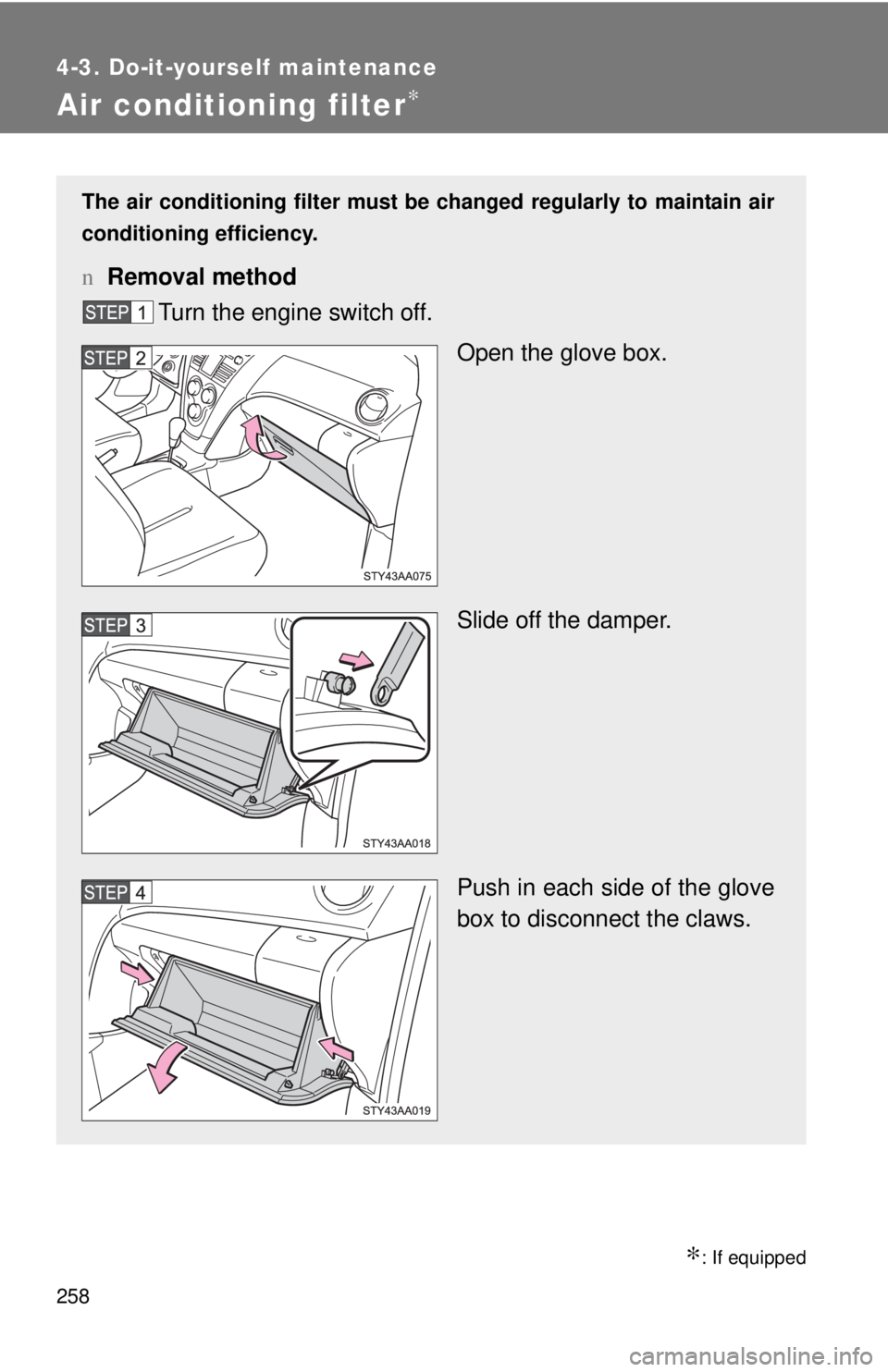
258
4-3. Do-it-yourself maintenance
Air conditioning filter∗
∗: If equipped
The air conditioning filter must be changed regularly to maintain air
conditioning efficiency.
n Removal method
Turn the engine switch off.
Open the glove box.
Slide off the damper.
Push in each side of the glove
box to disconnect the claws.
Page 270 of 386
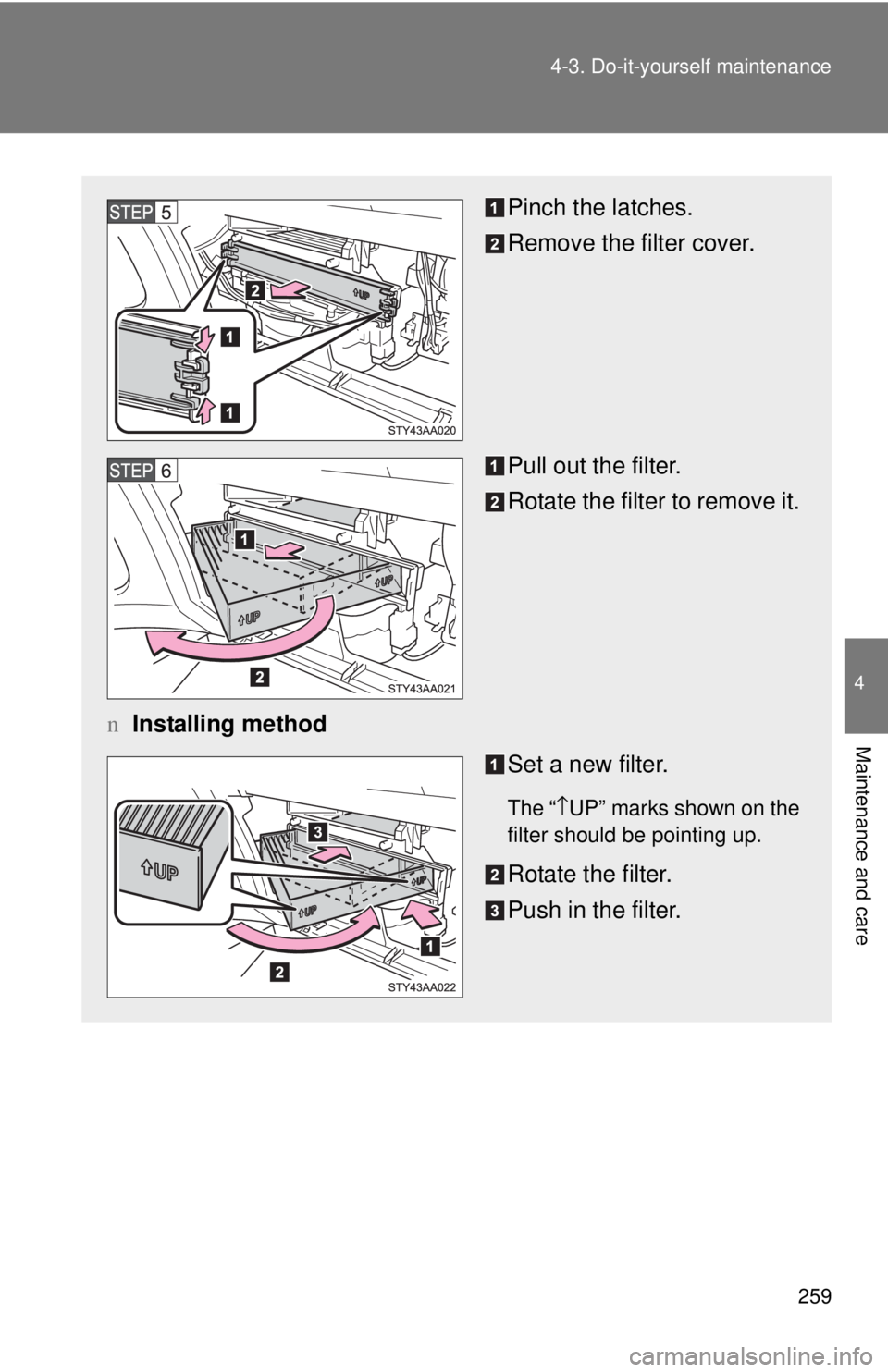
259
4-3. Do-it-yourself maintenance
4
Maintenance and care
Pinch the latches.
Remove the filter cover.
Pull out the filter.
Rotate the filter to remove it.
n Installing method
Set a new filter.
The “ ↑ UP” marks shown on the
filter should be pointing up.
Rotate the filter.
Push in the filter.